The cucumber melon or melon cucumber is a variety of the sugar melon. You can find out from us what the curious plant looks like, what varieties there are and how you can successfully grow cucumber melons.
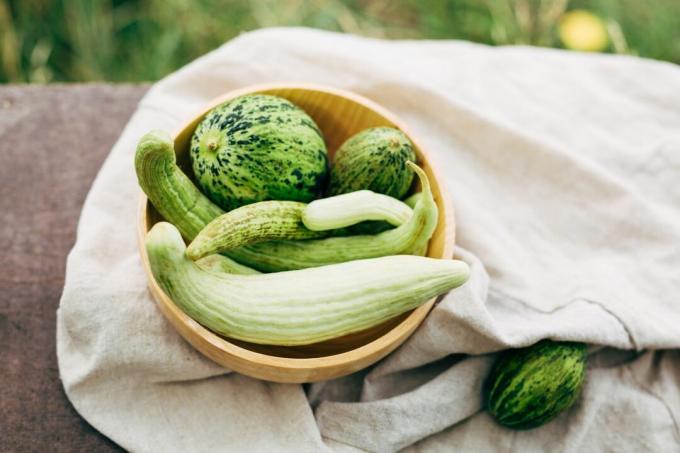
The cucumber melon (Cucumis melo var. flexuosus) looks very similar to a cucumber fruit on the outside, but hides juicy, mild flesh with a light melon flavor inside. We give tips on how to grow the melon cucumber in your own garden.
contents
- Cucumber melon: origin and properties
- The best varieties
- Plant cucumber melons and grow them yourself
- The right care
- Harvesting and use of the cucumber melon
Cucumber melon: origin and properties
The cucumber melon, also called melon cucumber, is a subspecies of the cantaloupe melon (Cucumis melo). She's pretty close with her cucumber (Cucumis sativus) related. However, cucumber melon and cucumber cannot mix with each other. The cucumber melon originally comes from the subtropics and tropics of Asia and came to Europe via Armenia. Today, the cucumber melon is a common vegetable in the Mediterranean region and the Black Sea, across southern Asia to Japan.

The annual cucumber melon grows climbing and is about 40 cm high, but thanks to its numerous branches it can reach up to 1 m2 take up space. The shoots of the pumpkin family (Cucurbitaceae) are rough and, like the entire plant, covered with stiff, short hairs. Its leaves are long-stalked and heart-shaped with serrated edges. Both tendrils and flower buds develop in the leaf axils.
The flowering time of the cucumber melon is between June and September if it is cultivated early in our latitudes. The melon variety forms lemon-yellow to sun-yellow petals in a funnel of 5 flowers that have grown together and are either purely female or purely male, i.e. only pollen to produce. Cucumber melons are cross-pollinators, so they rely on insects and offer them nectar and pollen for their pollination.
After pollination, the female flowers develop into spherical, oval or oblong, softly hairy, light green fruits, some of which have dark green stripes. Inside, the teardrop-shaped, creamy-white seeds of the melon cucumber ripen by late autumn.
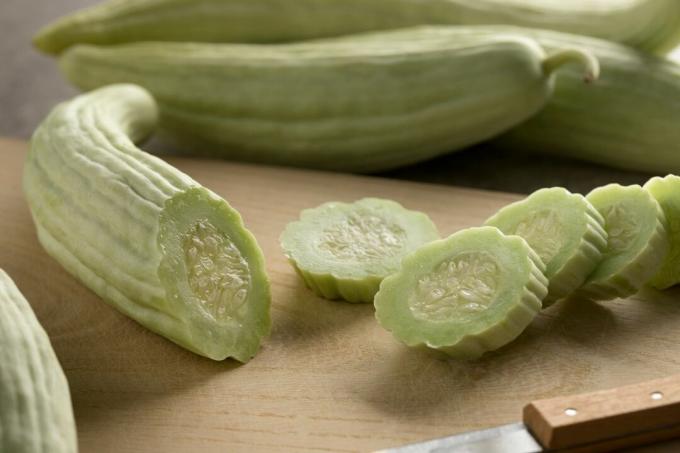
The best varieties
There are now several types of cucumber melons that differ in fruit shape, consistency and taste.
- 'Armenian': Also known as Armenian cucumber, this melon cucumber stands out thanks to its long, thin and heavily ribbed fruits that resemble light-colored snake cucumbers.
- 'barese': The high-yielding Italian cucumber melon features light green, teardrop-shaped fruits with pale green stripes. Young fruits are soft downy.
- ‘Mezza Lungo di Polignano’: This exceptional Italian cucumber melon has fruits about 15 cm long that are completely fluffy and hairy. However, the fluff does not bother you when eating, so you can simply enjoy the sweet and mild taste.
- 'Tondo di Fasano': This Italian cucumber melon produces spherical, grass-green fruits with white flesh, which are harvested when they are around 10 cm in diameter.
- 'Tondo di Manduria': This is a round to oval-round melon cucumber with light green skin and dark green stripes and very juicy, sweet and soft flesh.
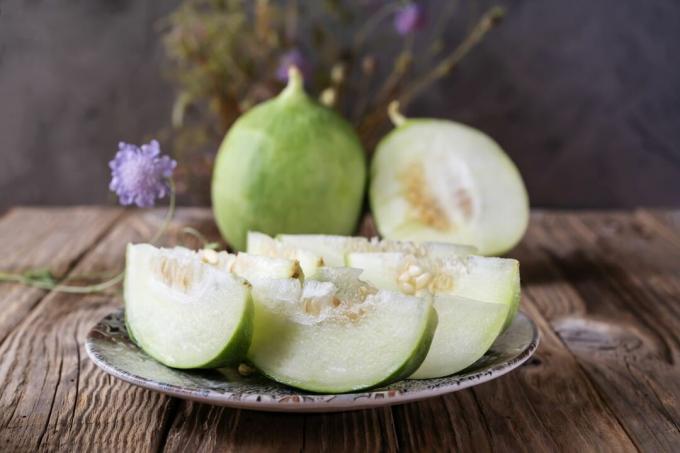
Plant cucumber melons and grow them yourself
The cucumber melon prefers sunny, warm and sheltered locations on loose, humus-rich and nutrient-rich soil with good water retention. The best place is in the greenhouse or on a south-facing house wall, as the plant needs a lot of warmth. But the pumpkin plant also feels at home in a pot on the balcony or in a raised bed, where it can be cultivated hanging down at the edge. In the bed, it is a good idea to plant the cucumber melon on a hill, as the soil there warms up faster and excess water can drain away. In addition, you should always grow at least two cucumber melons together, since cross-pollination produces significantly more fruit, usually of better quality. After the melon cucumber, a cultivation break of about 4 years should also be observed with other pumpkin plants.
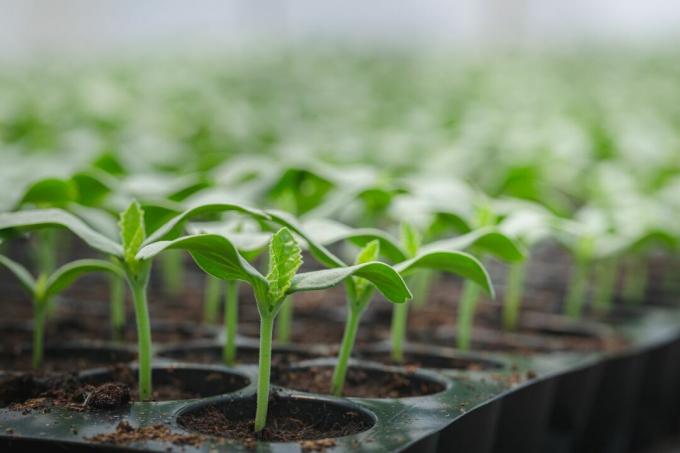
Like its relatives, the muskmelons and cucumbers, the melon cucumber is either grown indoors or sown directly after the last late frosts. However, growing indoors has the decisive advantage that the harvest is a few weeks longer early and in our latitudes therefore significantly more fruit developed by the end of the season in autumn will.
For the pre-culture, the seeds of the cucumber melon are placed in half-filled pots or multi-plates on a nutrient-poor substrate from the beginning of April, covered with 1 to 2 cm of soil and watered. Our peat-free Plantura Organic Herb & Seed Soil is ideal for cultivating vegetable plants, but also ideal for weakly consuming herbs. It stores moisture and releases it to the plant roots when needed, but at the same time ensures good ventilation and reduces the risk of waterlogging in the pot. The seed containers are then set up warm and bright at 20 to 25 °C. The first little plants can already be seen after 1 to 2 weeks.
If the plants protrude beyond the edge of the pot, they can be filled up to the top with nutrient-rich soil. Alternatively, prick and separate the cucumber melons as soon as the first true leaf can be seen. Before planting out, the seedlings should be acclimated to the sun's rays and outdoor temperatures by the hour.
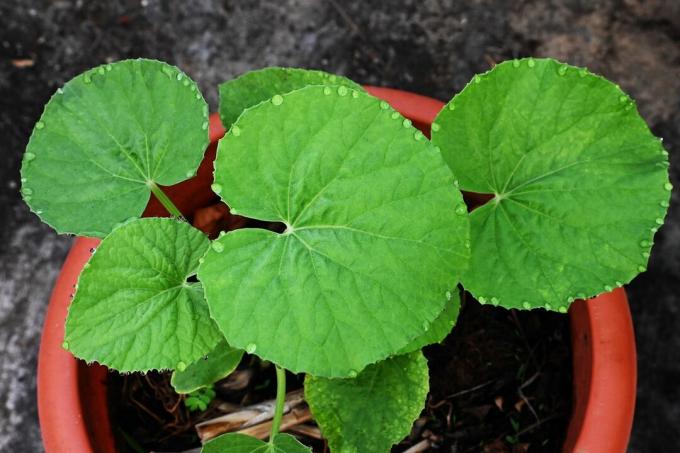
You can plant the cucumber melon from mid-May after the ice saints. Choose the right location for this and prepare the soil or a container with a volume of at least 15 to 20 liters and good water drainage. In the bed, the soil should be loosened and, if necessary, with mature compost or a long-term fertilizer like ours Plantura organic tomato fertilizer, to be enriched. A fertilizer application for the nutrient-hungry melon cucumbers at the planting stage supports vigorous growth and a good blossoming. The nutrient supply is slowly released over several weeks and thus prevents over-fertilization or undersupply in equal measure.
If you want to plant the melon cucumber in the pot, you should first fill in a 2 to 5 cm high drainage layer of expanded clay, gravel or sand in the bottom of the pot to prevent waterlogging. Then the pot is covered with a nutrient-rich potting soil like ours Plantura organic tomato & vegetable soil filled up. It has a high compost content, which promotes root formation and stores water. This makes it possible to completely do without peat, which is harmful to the climate. Here, too, compost or a predominantly organic long-term fertilizer can be mixed into the potting soil.
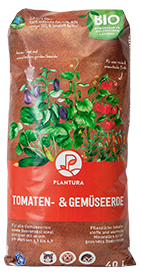
Plantura organic tomato & vegetable soil
Organic, peat-free & climate-friendly:
For all types of vegetables and berries,
ensures a rich and aromatic harvest, harmless to humans and animals
Cucumber melons are planted just as deep in the ground as they were in the pot before. The planting distance is 50 cm between the plants and about 100 cm between individual rows. Then press the soil around the young plant lightly and water vigorously. If the melon cucumbers are cultivated vertically, a climbing aid should be planted in the ground or the plants raised. You can also find ideas and different types of climbing frames in our article on climbing aids for cucumbers.
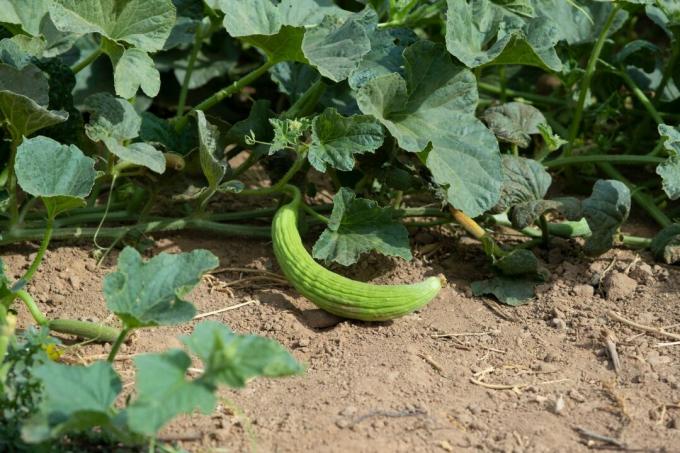
The right care
Cucumbers, like other cucurbits, are thirsty and nutrient-hungry plants. They should be watered regularly, especially in summer, the soil must never dry out completely. Warmed rainwater from the barrel is ideal for this; water that is too cold can lead to stunted growth and cold damage to the roots. At best, never water over the leaves, only directly onto the soil to avoid diseases like this mildew to prevent
Fertilization is a second important care measure if you want to successfully grow cucumber melons. The climbing melon plants need a constant supply of nitrogen and potassium, especially during the flowering period and fruit formation. If a long-term fertilizer granulate was already added to the planting, it only has to be fertilized after about three months. However, it is not so easy to incorporate fertilizer, especially with potted plants and plants that climb the ground. Here you can use an organic liquid fertilizer like ours Plantura Organic Tomato & Vegetable Fertilizer, To fall back on. This is simply applied over the irrigation water about once a week, acts quickly and can even help with acute deficiency symptoms.

Plantura Organic Tomato & Vegetable Fertilizer
Highly effective organic liquid fertilizer
with an NK ratio of 4-5
for all types of vegetables & berries,
safe for pets and garden animals
Pinching is one way to encourage more branching in the melon plants. This makes sense especially for plants that climb on the ground. Here the shoot tip is cut off after about 5 leaves. Now the main shoot branches out and forms numerous side shoots, which lead to more compact growth overall. Pinching also encourages fruit growth because the plant puts its energy into the fruit rather than the shoot tip.

Harvesting and use of the cucumber melon
The melon cucumber can be harvested very young and used just like a cucumber. Their skin is much more delicate than that of cucumbers and the flesh has a mild sweetness in addition to a strong cucumber aroma. They are therefore an ideal substitute for people who do not tolerate cucumbers well, because melon cucumbers do not contain any bitter substances such as cucurbitacin. With the elongated cucumber melons, the harvest time is reached as soon as they are between 15 and 25 cm long. The round to oval varieties are harvested with palm-sized fruits that have reached a diameter of about 10 to 12 cm. A sharp knife or secateurs are ideal for harvesting the fruit with as few injuries as possible.

Alternatively, the fruits can be left on the plant a little longer, which develops a more melon-like taste with even more sugar. The fruits are cool but not below 10 °C for only a few days and should therefore be eaten quickly. Whether as a cucumber salad, stewed and fried in Asian curries or as a snack in between, the melon cucumber can be used anywhere in the kitchen where cucumbers or melons are also used would. Of course, cucumber melons can be preserved. You don't actually need any sugar, as the fruits themselves are sweeter than normal cucumbers. As preserve cucumbers you can find out in our special article.
Another fruit that is still unknown to us is the pear melon (Solanum muricatum), also called Pepino. We present the nightshade plant (Solanaceae) and its requirements in terms of location, cultivation and care in the profile.
...and receive concentrated plant knowledge and inspiration directly in your e-mail inbox every Sunday!



